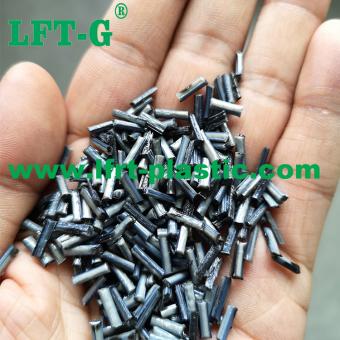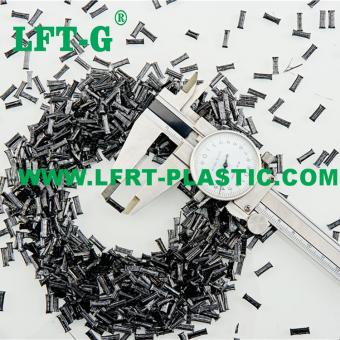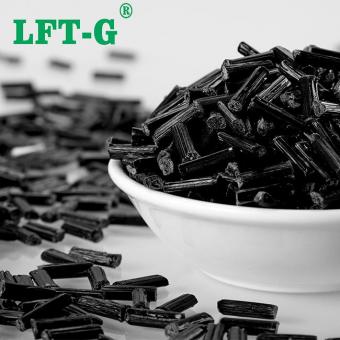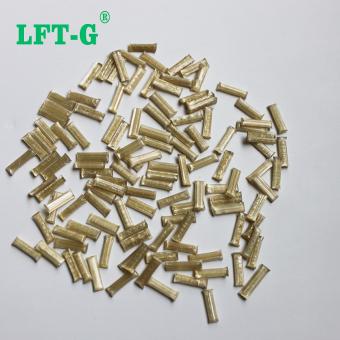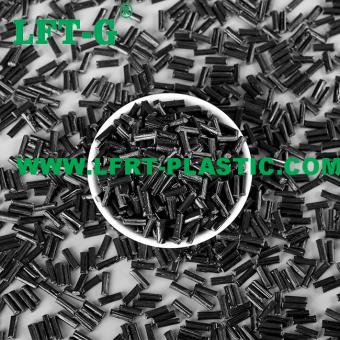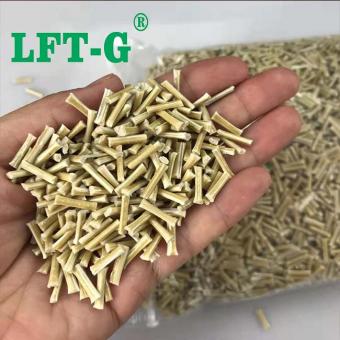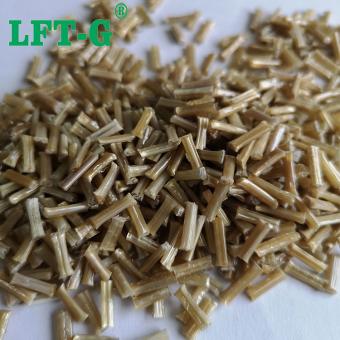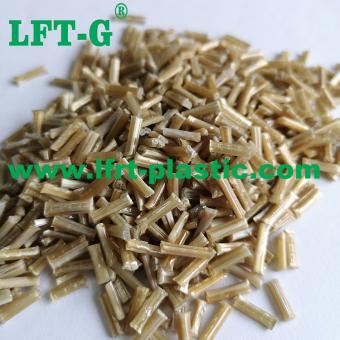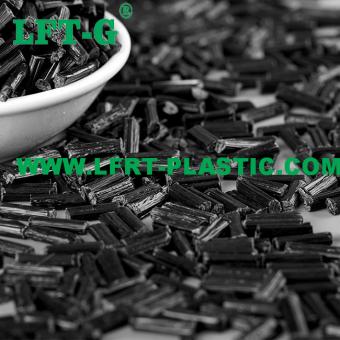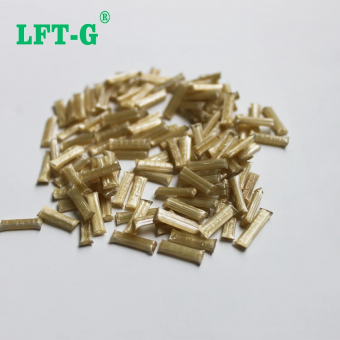-
LFT-G PEEK high quality modified materials fill long carbon fiber for automotives good performanceThroughout the plastics industry, PEEK is widely recognized as a leading high performance polymer (HPP). However, the preferred material in the automotive, aerospace, oil and gas, and medical device industries has long been metal, and PEEK polymers are rapidly changing that mindset. What is the PEEK material PEEK or Polyetheretherketone belongs to the class of polymers known as "aromatic polyketones" (more accurately Polyaryletherketone or PAEK). Research and development of PEEK began in the 1960s, but it wasn't until 1978 that Imperial Chemical Industries (ICI) patented PEEK, and Victrex PEEK polymer was first commercialized in 1981. "Aromatic" usually implies a distinctive or sweet flavor, which may seem like an odd term, but scientists use it to describe certain molecules that contain or consist of a cyclic structure (such as the aryl unit above). Small molecules of this type, such as toluene and naphthalene, have distinctive odors and hence the name. However, PEEK itself, like most thermoplastics, is odorless under normal conditions. Chemically, PEEK is primarily a linear semi-crystalline polymer. P comes from the Greek word "poly" meaning "many", so many EEKs form PEEK. aryl and ketone groups provide stiffness by being somewhat rigid, which means good mechanical properties and a high melting point. The ether group provides a degree of flexibility, while the aryl and ketone groups are chemically inert and thus chemically resistant. The regular structure of the repeating units means that the PEEK molecule can be partially crystallized and the crystallinity provides properties such as wear resistance, creep resistance, fatigue resistance and chemical resistance. The resulting polymer is widely recognized as one of the best performing thermoplastics in the world. Compared to metals, PEEK-like materials are lightweight, easy to mold, corrosion-resistant, and have a fairly high specific strength (strength per weight). Datasheet for reference When high performance is required, PEEK as the polymer of choice offers more than just two or three properties, it offers a wide range of excellent properties including: - High heat resistance Testing has shown that LFT-G's PEEK polymer has a continuous use temperature of 260°C (500°F). This allows for a wide range of applications in hot corrosive environments such as the process industry, oil and gas industry, and the engines and transmissions of countless vehicles.PEEK resists friction and wear in dynamic applications such as thrust washers and seals. - Chemically Inert PEEK resists damage caused by chemically corrosive working environments such as downhole environments in the oil and gas industry, and gears in mechanical and automotive applications. It is resistant to jet fuels, hydraulic fluids, de-icers and pesticides used in the aerospace industry for a wide range of pressures, temperatures and time frames. - Strong mechanical properties PEEK exhibits excellent strength and stiffness over a wide range of temperatures, and the specific strength of PEEK-like carbon fiber composites is many times higher than that of metals and alloys. "Creep" is the permanent deformation of a material under constant stress over a period of time. "Fatigue" is the brittle destruction of a material under repeated cyclic loading. Because of its semi-crystalline structure, PEEK has high creep and fatigue resistance and is more durable than many other polymers and metals over a long service life. - Does not ignite or burn easily PEEK has excellent flame resistance, with an ignition temperature of nearly 600°C. Even when ignited at very high temperatures, it does not burn continuously and emits little smoke. This is one of the reasons why PEEK is widely used in commercial aircraft. - Reprocessable and recyclable PEEK molecules are so stable that they can be melted and reprocessed time and time again with minimal impact on their properties. This helps to improve the environmental footprint and ensures more efficient reuse of waste materials generated during the manufacturing process. - And there's more! PEEK is also non-hygroscopic, so its properties are not altered in wet environments; it is resistant to gamma and electron beam radiation and is transparent under X-ray exposure, making it attractive for medical device applications.PEEK is also electrically stable and is typically used as an electrical insulator, but can be modified to become a conductor or static dissipative material. As a thermoplastic PEEK, it can be injection molded, compression molded and extruded using conventional thermoplastic processing equipment. It is very versatile and its use is becoming more and more common to improve component performance, durability, reduce weight and lower overall system costs over its lifetime. There is no doubt that it is replacing metals and alloys. In many industries and critical environments, material specialists, part designers and buyers must choose between PEEK and traditional metals a...
- High performancePEEK fiiler lcf
- Injection molded PEEK good price
- composite plastic peek black color
- made in China peek reinforced materials
- aerospace automotive parts plastic
- Low warpage PPS reinforced long carbon fiber
Tags :
-
LFT-G High toughness PPS composite long carbon fiber polymers original colorThe introduction of PPS Specialty engineering plastics PPS has excellent performance, its molecular structure is relatively simple, the main chain of the molecule by the benzene ring and sulfur atoms are arranged alternately, a large number of benzene ring to give PPS with rigidity, a large number of sulfur ether bonds and provide flexibility. PPS has the advantages of hard and brittle, high crystallinity, flame retardant, good thermal stability, high mechanical strength and excellent electrical properties. It is the product at the top of the plastic pyramid. Why PPS fiiling Long carbon fiber? Polyphenylene sulfide (PPS) modified with glass fibers, carbon fibers, and other materials increases the electrical conductivity, thermal conductivity, heat resistance, abrasion resistance, high strength, hydrolysis resistance, and other material characteristics. Thus, the formation of a special engineering plastics according to the unique features. Long fiber composite material is the most important feature is to have the original material does not have superior performance, if you join the length of the reinforcing material to be classified, it can be divided into: long fiber, short fiber and continuous fiber composite materials. In the composite material made of fibers is sheared or pulled, the fibers are pulled out from the matrix, such a pulling process is conducive to the absorption of energy provided by the loading, the longer the fibers are within a certain length, the greater the absorption of energy, and the more significant its strength. And in the same volume amount, due to the longer the single fiber, the fewer the number of fiber roots, the less stress concentration generated at the fiber end, the more difficult the destruction of the material. From the results of the feedback of practical applications, the various properties of long carbon fiber reinforced thermoplastic composites are more excellent than those of short fibers. In addition, carbon fiber reinforced composites in the friction process, the fiber body plays an important role in lubrication, long distance carbon fiber can be much more sustainable, stable lubrication, so the coefficient of friction is lower, less wear, and the formation of finer abrasive debris. Due to such advantages, long carbon fiber reinforced thermoplastic composites are not afraid of high frequencies and loads, and perform much better in practical applications. Datasheet of PPS-LCF for reference Application of PPS-LCF Packing details Choose us Xiamen LFT composite plastic Co., Ltd. has advanced production equipment and testing instruments, professional technology research and development team, rich production experience, perfect management system; after many years of technical accumulation, developed a long-fiber modified multi-series products, and accumulated a full range of material solutions, to provide customers with free technical support.
- Specialty Engineering Plastics PPS injection molded
- PPS LCFR high rigidity lft-g
- PPS long carbon fiber extrusion
- PPS polyphenylent for car parts
- recycled pps for industry use
- Long carbon fiber Reinforced Polypropylene for electrial accessories
Tags :
-
Xiamen LFT-G Copo Polypropylene filling LGF 20-60 injection molded reinforced PlasticAbout LFT materials Long-fiber thermoplastics (LFTs) have long been used in the automotive industry, especially in products based on polypropylene (PP materials), which offer light weight, strength and design freedom to replace metals in certain structural applications. LFT compounds have excellent mechanical properties and are therefore well suited for metal replacement and lightweighting, thereby reducing carbon footprints. Automotive, transportation and industrial are the main markets for LFT materials, where weight reduction is the main objective. The extremely high mechanical properties of Long fiebr compounds become better compared to the same formulations with short fibers. For example, the impact of energy impact absorption is two to three times higher. While LFT is still a more expensive material option than short fiber compounds, the combination of great performance gains and sustainability will be attractive to many end users. About the Long glass fiber Long carbon fiber composites is one kind of long fiber reinforced composites, which is a new type of fiber material with high strength and high modulus fiber.LCF carbon fiber composites show high strength along the fiber axis direction, and have the characteristics of high strength, light weight, etc., and have a full range of mechanical properties such as density, specific strength, specific modulus and so on, which are incomparable with other materials, and it is a new material with excellent mechanical properties and a lot of special It is a new material with excellent mechanical properties and many special functions. Advantages Corrosion resistance: LCF carbon fiber composite material has good corrosion resistance and can adapt to the harsh working environment. UV resistance: strong ability to resist ultraviolet rays, the products are less problematic to be harmed by ultraviolet rays. Abrasion and impact resistance: the advantages are more obvious than general materials; and Low density: lower density than many metal materials, to achieve the purpose of lightweight. Other properties: such as reducing warpage, improving rigidity, impact modification, increasing toughness, electrical conductivity and so on. LCF carbon fiber composites have higher strength, higher rigidity, lower weight, and excellent electrical conductivity compared to glass fiber. Datasheet of PP-LCF Application Processing About us
- Low warpage electronic appliance
- LFT materials PP green materials
- customized pps made in China
- car parts automotive parts lgfrp materials
- can be recycled pp raw materials lft
Tags :
-
Xiamen LFT-G raw material PPS composite long glass fiber for home appliances parts and so onProduct number: PPS-NA-LGF Fiber specification: 20%-60% Feature: 94-VO Flame retardant, high toughness, low warpage, fatigue resistance, good appearance of the product Application: Water heater impeller, pump shell, joint, valve, chemical pump impeller, shell, cooling water impeller, shell, home appliances parts
- 94-VO Flame retardant pps virgin grade
- High toughness self-owing factory
- Low warpage injection molded
- Water heater impeller supplier price
- Pump shell high mechanical properties
- Sample available best price
Tags :
-
Xiamen LFT-G Polyphenyl sulfide filling 20%-60% Long carbon fiber flame retardant grade for auto partsPolyphenylene sulfide is a new functional engineering plastic.
- Polyphenyl sulfide long carbon fibre
- PPS plastic rigid and opaque polymer
- Composite material resists creep pps
- Filling lcf 30 high-temperature engineering thermoplastic
- High flame retardant
- Factory use raw material
Tags :
-
Xiamen LFT-G Polyphenyl sulfide filled 30% LCF PPS flame retardant grade UL-94 V0Polyphenylene sulfide is a new functional engineering plastic.
- PPS plastic rein forced compounds
- Composite material pps industrial use
- Filling lcf 30 pps composite plastic new materials
- High flame retardant car parts
- Factory use raw material modified plastic high performance
Tags :
-
LFT polyphenylene sulfide Long Fiber Thermoplastic PPS LGF40% CompositeProduct Name: Long glass fiber 40% Fill PPS Length:About 12mm Applicaiton:Auto parts, energy components and other plastic partsview more
-
Xiamen LFT-G PPS Polyphenylene sulfide composite long glass fiber thermoplastic original colorPPS information The resin matrix of thermoplastic composites involves general and special engineering plastics, and PPS is a typical representative of special engineering plastics, commonly known as "plastic gold". Performance advantages include the following aspects: excellent heat resistance, good mechanical properties, corrosion resistance, self-flame retardant up to UL94 V-0 level. Because PPS has the advantages of the above properties, and compared with other high performance thermoplastic engineering plastics and has the characteristics of easy processing, low cost, so it becomes an excellent resin matrix for manufacturing composite materials. PPS composite material PPS filling short glass fiber (SGF) composite material has the advantages of high strength, high heat resistance, flame retardant, easy processing, low cost, and has been applied in automotive, electronics, electrical, machinery, instruments, aviation, aerospace, military and other fields. PPS filling long glass fiber (LGF) composite material has the advantages of high toughness, low warpage, fatigue resistance, good product appearance and so on. It can be used in water heater impeller, pump shell, joint, valve, chemical pump impeller and shell, cooling water impeller and shell, household appliance parts and so on. What are the specific differences between short glass fiber (SGF) and long glass fiber (LGF) reinforced PPS composites? 1. Mechanical property analysis The reinforcement fiber added in the resin matrix can form a supporting skeleton, and the reinforcement fiber can effectively bear the external load when the composite is subjected to external force. At the same time, energy can be absorbed by fracture, deformation and other ways to improve the mechanical properties of resin. The tensile strength and bending strength of the composites are gradually increased by increasing the amount of glass fiber. The main reason is that when the glass fiber content increases, more glass fiber in the composite material can withstand the action of external force. Meanwhile, due to the increase in the number of glass fibers, the resin matrix between the glass fibers becomes thinner, which is more conducive to the construction of glass fiber reinforced frame. Therefore, with the increase of glass fiber content, more stress is transferred from resin to glass fiber under external load, which effectively improves the tensile and bending properties of composite materials. The tensile and bending properties of PPS/LGF composites are higher than those of PPS/SGF composites. When the glass fiber mass fraction is 30%, the tensile strength of PPS/SGF and PPS/LGF composites is 110MPa and 122MPa, respectively. The bending strength was 175MPa and 208MPa, respectively. The flexural elastic modulus were 8GPa and 9GPa, respectively. The tensile strength, bending strength and bending elastic modulus of PPS/LGF composites are increased by 11.0%, 18.9% and 11.3% compared with PPS/SGF composites, respectively. PPS/LGF composites have higher length retention rate of glass fiber. Under the condition of the same glass fiber content, the composites have stronger load resistance and better mechanical properties. When the glass fiber content is low, the impact strength of the composite decreases. The main reason is that the lower glass fiber content cannot form a good stress transfer network in the composite material, so that the glass fiber exists in the form of defects under the impact load of the composite material, resulting in the overall impact strength of the composite material is reduced. With the increase of the glass fiber content, the glass fiber in the composite can form an effective spatial network, and the reinforcement effect is greater than that of the glass fiber tip. Under the action of external load, the external load can be transferred to the reinforced fiber better, thus improving the overall performance of the composite. In the PPS/LGF system, the length of the glass fiber is longer and the spatial network is more dense. The reinforced glass fiber has greater bearing capacity and better impact strength. When the mass fraction of glass fiber is 30%, the impact strength of PPS/LGF is increased by 19.4% from 31kJ/m2 to 37kJ/m2, and the notch impact strength is increased by 54.5%(from 7.7kJ/m2 to 11.9kJ/m2). 2. Thermal properties analysis of PPS/SGF and PPS/LGF composites When the mass fraction of glass fiber is 30%, the thermal deformation temperature of PPS/SGF composite and PPS/LGF composite reaches 250℃ and 275℃, respectively. The thermal deformation temperature of PPS/LGF composite is 10% higher than that of PPS/SGF composite. The main reason is that the introduction of glass fiber makes the network skeleton of reinforced fiber formed inside the composite material, which greatly improves the heat resistance of the composite material. The size of glass fiber in PPS/LGF is longer, and the heat resistance improvement advantage is more obvious....
- New high performance thermoplastic resin
- A crystalline polymer reinforced plastic pps
- Long glass fiber filling plastic
- Customized material PPS self factory made
- Industrial raw material thermoplastic ppa
- High impact resistance lgf
Tags :
-
Xiamen LFT-G Polyphenyl Sulfide PPS filled carbon fiber flame retardant UL-94Polyphenylene sulfide is a new functional engineering plastic.
- Polyphenyl sulfide pps high temperature resistance
- PPS plastic thermoplastic resin carbon fiber
- Composite material PPS modified plastic filament
- Filling lcf 30 LFT CFRP carbon fiber reinforced
- High flame retardant PPS self factory made
- Factory use raw material can be recycled pps
Tags :
-
LFT-G PPS Polyphenylene sulfide LGF composite long glass fiber customized engineering plasticsWhat is the PPS? Polyphenylene sulfide (PPS) is a new thermoplastic resin with high performance. By filling, modified with excellent high temperature resistance, corrosion resistance, wear resistance, flame retardant, balanced physical and mechanical properties and excellent dimensional stability and excellent electrical properties and other characteristics of the new high performance thermoplastic resin, as well as high mechanical strength, chemical resistance, flame resistance, good thermal stability, excellent electrical properties and other advantages. It has the advantages of hard and brittle, high crystallinity, inflammability, good thermal stability, high mechanical strength, excellent electrical properties, strong chemical corrosion resistance and so on. The mechanical properties of pure PPS are not high, especially the impact strength is relatively low. Good creep resistance under load, high hardness; High wear resistance, the wear at 1000 RPM is only 0.04g, and will be further improved after filling F4 and molybdenum disulfide; It also has a certain degree of self-moistening. The mechanical properties of PPS are less sensitive to temperature. What is the PPS-LGF? PPS is one of the best varieties of heat resistance in the engineering plastic department. The thermal deformation temperature of the material modified by glass fiber is generally greater than 260 degrees, and the chemical resistance is second only to PTFE. In addition, it also has small shrinkage, low water absorption, good fire resistance. Good resistance to vibration fatigue, strong resistance to arc, especially at high temperature. Excellent electrical insulation in high humidity. But its disadvantages are brittleness, toughness, low impact strength, after modification, can overcome the above shortcomings, obtain very excellent comprehensive performance. As a plastic, its properties and uses far exceed those of ordinary plastics, and in many ways it is as good as metal materials. Excellent material PPS has the advantages of high temperature corrosion resistance, excellent mechanical properties, can replace metal including stainless steel, copper, aluminum, alloy, etc., is considered to be the best substitute for metal, copper. What is the application of PPS-LGF? PPS is now widely used in automotive, aerospace, household appliances, mechanical construction and chemical industry for a variety of structural parts, transmission parts, insulation parts, corrosion resistant parts and seals. Under the condition of ensuring sufficient strength and other properties, the weight of the product is greatly reduced. Datasheet for reference Details Number Color Length MOQ Package Sample Delivery time Port of Loading PPS-NA-LGF30 Original color (can be customized) 5-25mm above 25kg 25kg/bag Available 7-15 days after shipment Xiamen Poer Production process Trademarks and patents Teams and customers We will offer you: 1. LFT & LFRT material technical parameters and leading edge design 2. Mold front design and recommendations 3. Provide technical support such as injection molding and extrusion molding.
- PPS Long glass fiber 40
- pps compounds lgf
- pps resin materials lft
- lft-g pps reinforced plastic
- long glass fiber filling pps
- termoplastic resin pps lgf
Tags :
-
LFT-G PPS Polyphenylene sulfide with long carbon fiber thermoplastic resin high rigidity and strengthPPS Information Polyphenylene sulfide (PPS) is not enhanced before modification, its disadvantages are brittle, poor toughness, low impact strength, after filling glass fiber, carbon fiber and other enhancements modified to overcome the above shortcomings, to obtain very good overall performance. PPS filling Long carbon fiber In the modified engineering plastics industry, long fiber reinforced composites are composites made from long carbon fibers, long glass fibers and polymer matrix through a series of special modification methods. The most important feature of long fiber composites is that they have superior performance that the original materials do not have. If we classify them according to the length of the reinforcing materials added, they can be divided into: long fiber, short fiber and continuous fiber composites. Long carbon fiber composites are one kind of long fiber reinforced composites, which are a new fiber material with high strength and high modulus. It is a new material with excellent mechanical properties and many special functions. Corrosion resistance: LCF carbon fiber composite materials have good corrosion resistance and can adapt to the harsh working environment. UV resistance: the ability to resist UV is strong, and the products are less damaged by UV. Abrasion and impact resistance: the advantage of comparing with general materials is more obvious. Low density: lower density than many metal materials, can achieve the purpose of light weight. Other properties: such as reducing warpage, improving rigidity, impact modification, increasing toughness, electrical conductivity, etc. LCF carbon fiber composites have higher strength, higher rigidity, lower weight, and excellent electrical conductivity compared with glass fiber. PPS TDS for reference PPS Application Other products you can also contact us for more technical advice. Q&A 1. Are carbon fiber composite products very expensive? The price of carbon fiber composite products is closely related to the price of raw materials, the level of technology and the number of products. The higher the performance of the raw material, the more expensive it is, such as the carbon fiber PEEK thermoplastic material used in orthopedics. Of course, the more complex the manufacturing process, the greater the working time and workload, and the increased production costs. However, the larger the order quantity, the lower the cost per product. In the long run, the superior performance of carbon fiber will extend the life of the product, reduce the number of maintenance, and is also very beneficial to reduce the cost of use. 2. Are carbon fiber composite products toxic? Carbon fiber composites are made of carbon fiber filaments mixed with ceramics, resins, metals and other substrates, and are generally not toxic. For example, the above-mentioned PEEK material is made of food-grade resin, which is very compatible with the human body and is not only harmless to humans, but also becomes a more ideal material for orthopedic surgery because of its high strength and elastic modulus close to the bone cortex. Carbon fiber medical bed plate, will be in daily contact with many patients body, will not have adverse effects on the human body, on the contrary, for the accuracy of medical diagnosis and a great help. 3. What is the difference between thermosetting carbon fiber composites and thermoplastic carbon fiber composites? Thermoset carbon fiber composites favor the role of curing agent in curing and molding. While thermoplastic carbon fiber composite products mainly rely on cooling down to achieve the shaping. Thermoplastic carbon fiber composites are not as popular as thermoset carbon fiber composites, mainly because they are expensive and are generally used in high-end industries. Thermoset carbon fiber composites are difficult to recycle due to the limitation of the resin matrix itself, and are generally not considered; thermoplastic carbon fiber composites can be recycled, and can be made twice as long as they are heated to a certain temperature. About us We will offer you: 1. LFT & LFRT material technical parameters and leading edge design 2. Mold front design and recommendations 3. Provide technical support such as injection molding and extrusion molding
- PPS polyphenylent with addition and filler
- pps lcf40 granules raw material
- pps LCf40 plastic injection part
- carbon fibre reinforced pps lcf pellet
Tags :
-
LFT Polyphenylene sulfide PPS Long Glass fiber Reinforced PPS PelletsEngineer PPS filled Long Glass fiber Reinforcedis one kind of engineering modifeid plastic materials of long glass fiber reinforced PPS
- PPS filled Long glass fiber
- Polyphenylene sulfide PPS anti aging
- PPS Polymer pellets
- Modified PPS
- Thermoplastic Reinforced plastic PPS
Tags :

 e-mail
e-mail English
English français
français Deutsch
Deutsch русский
русский italiano
italiano español
español português
português العربية
العربية 日本語
日本語 한국의
한국의 中文
中文












